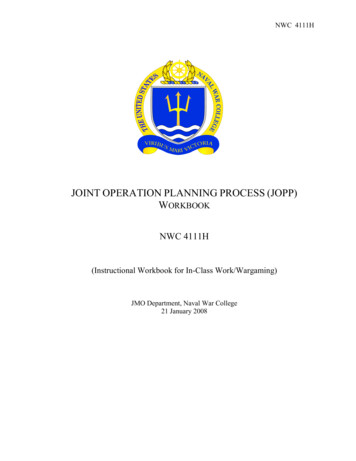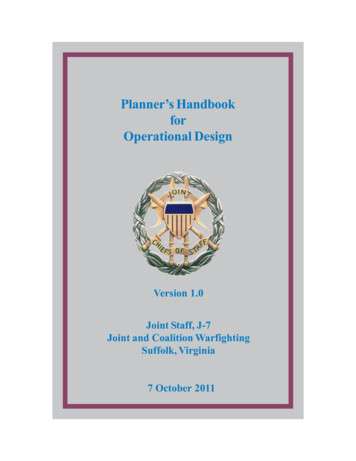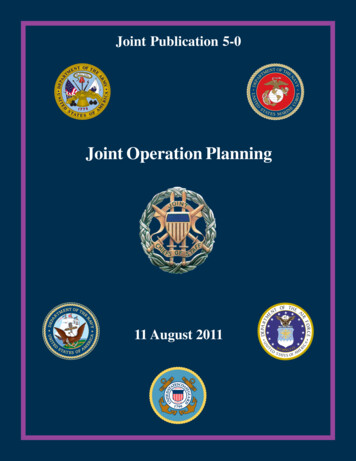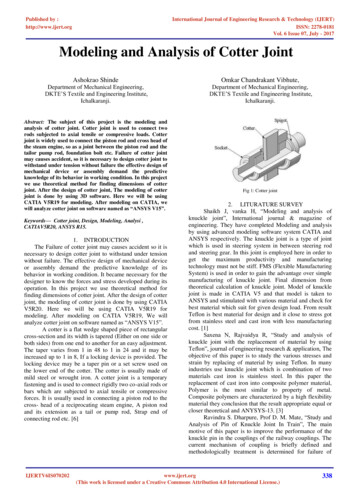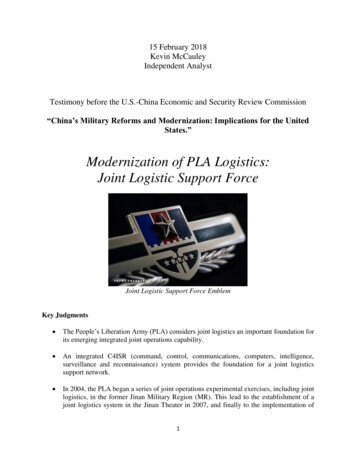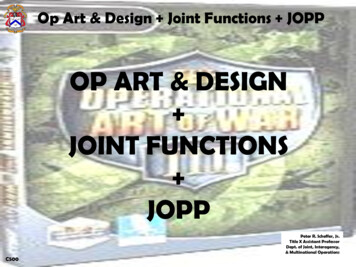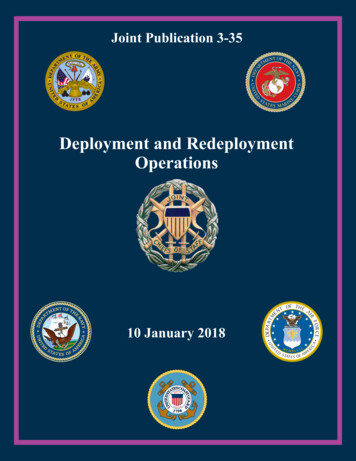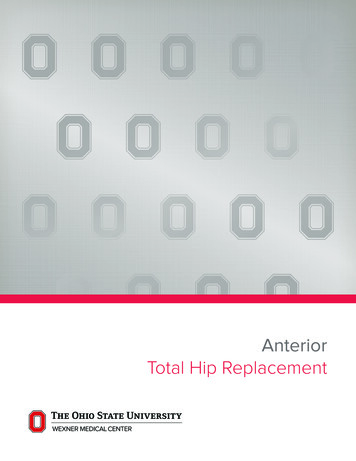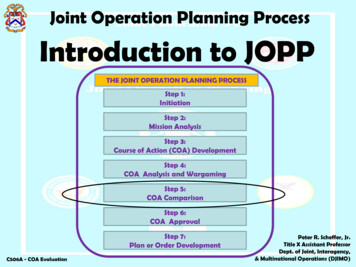
Transcription
Joint Operation Planning ProcessIntroduction to JOPPTHE JOINT OPERATION PLANNING PROCESSStep 1:InitiationStep 2:Mission AnalysisStep 3:Course of Action (COA) DevelopmentStep 4:COA Analysis and WargamingStep 5:COA ComparisonStep 6:COA ApprovalStep 7:Plan or Order DevelopmentC506A - COA EvaluationPeter R. Scheffer, Jr.Title X Assistant ProfessorDept. of Joint, Interagency,& Multinational Operations (DJIMO)
Joint Operation Planning ProcessWe are Here C506A - COA Evaluation
Joint Operation Planning ProcessCOA Comparison“Governing Factors”C506A - COA Evaluation
Joint Operation Planning Process COA Comparison: “An objective process whereby COAs are considered independently of each otherand evaluated/compared against a set of criteria that are established by the staffand commander.” The goal is to identify the strengths and weaknesses of COAs so that a COA withthe highest probability of success can be selected and developed. The commander and staff analyze each tentative COA separately according to thecommander’s guidance. COA analysis identifies advantages and disadvantages of each proposed friendly COA. Governing Factors: “Those aspects of the situation (or externally imposed factors) that the commanderdeems critical to mission accomplishment.” Governing Factors are key outputs of COA Analysis and Wargaming and keyinputs to COA Comparison. The staff evaluates COAs using Governing Factors to identify the one with thehighest probability of success. Governing Factors are criteria! Potential Governing Factors include elements of the commander’s intent andplanning guidance; wargaming results; principles of joint operations; operationallimitations or any other criteria the commander desires.C506A - COA Evaluation- JP 5-0, Joint Operation Planning1
Army Operation Planning Process Evaluation Criteria are “factors the commander and staff will later use to measurethe relative effectiveness and efficiency of one COA relative to other COAs.” Evaluation Criteria address factors that affect success and those that can causefailure. The staff presents proposed Evaluation Criteria to the commander at the MissionAnalysis briefing for approval. Proposed Evaluation Criteria are a key output of Mission Analysis and a key inputto COA Development. Refined Evaluation Criteria are a key output of COA Development and a keyinput to COA Comparison. Evaluation Criteria may be weighted based on their relative importance and thecommander’s guidance. “COA Comparison is an objective process to evaluate COAs independently of eachother and against set criteria approved by the commander and staff.” The goal is to identify the strengths and weaknesses of COAs and enable selectionof a COA with the highest probability of success for further development.C506A - COA Evaluation- ADP 5-0, The Operations Process2
USMC Operation Planning Process In COA Comparison and decision, the commander evaluates all friendlyCOAs against established criteria, evaluates them against each other, andselects the COA that will best accomplish the mission. COA Evaluation and COA Comparison occur during Step 4 (Course ofAction Comparison and Decision) of the Marine Corps Planning Process. The commander uses the information gathered, which was based on hisEvaluation Criteria, to select a COA to develop into the concept of operations. Each COA is examined against the commander’s Evaluation Criteria. The results of COA Evaluation allow the commander to conduct COAComparison. The commander may use a comparison and decision matrix to helpcompare one COA against another. COA Comparison provides the commander with an understanding of therelative merit of each COA. The commander’s Evaluation Criteria addresses specific issues and/orquestions the commander wants the staff to determine on each COA duringthe conduct of the wargame.C506A - COA Evaluation- MCWP 5-1, w/Chg 1, Marine Corps Planning Process3
Army Operation Planning ProcessElements of Evaluation Criteria*/ Governing FactorsShort Title: The criterion name.Definition: A clear description of the feature being evaluated.Unit of Measure: A standard element used to quantify the criterion.Benchmark: A value that defines the desired state, or “good” for a solution interms of a particular criterion. The standard or basis for determining relative advantage ordisadvantage of a particular COA. Benchmark sources may include regulation, historical precedent,experience, and averaging.Formula: An expression of how changes in the value of the criterion affect thedesirability of the possible solution. The formula may be stated in comparative or absolute terms.C506A - COA Evaluation- ADP 5-0, The Operations Process4
Joint Operation Planning Process--Joint Challenge-“Governing Factors”C506A - COA Evaluation
Joint Operation Planning Process“Joint Challenge” Governing Factors1. Risk of Triggering Deployment of IRS Forces2. Risk of Coalition Casualties in Event of Attack3. Time to Emplace FDOs4. Time for Coalition to Seize Initiative5. Amount of Destruction to GOI Military & Infrastructure6. Risk that IDP Issues Affect Operations (IO, Sanctuary,Interference)7. Risk of Diminishing International Support8. Ability of AQ to Disrupt Coalition OperationsC506A - COA Evaluation5
Joint Operation Planning ProcessGoverning Factor #1Short Title: Risk of Triggering Deployment of IRSForcesDefinition: The level of risk of risk of triggeringdeployment of IRS forcesUnit of Measure: Gradations (Low, Medium or High)Benchmark: MediumFormula: Low is an advantage; medium is neutral;high is a disadvantage; less is betterC506A - COA Evaluation6
Joint Operation Planning ProcessGoverning Factor #2Short Title: Coalition CasualtiesDefinition: The degree of risk of coalition casualtiesin event of an attackUnit of Measure: Gradations (Low, Medium, orHigh)Benchmark: MediumFormula: Low is an advantage; medium is neutral;high is a disadvantage; less is betterC506A - COA Evaluation7
Joint Operation Planning ProcessGoverning Factor #3Short Title: Time to Emplace FDOs*Definition: The amount of time needed employDiplomatic, Informational, Military and EconomicFlexible Deterrent OptionsUnit of Measure: DaysBenchmark: 150**Formula: Less than or equal to 150 days is anadvantage; more then 150 days is a disadvantage;less is better* Based on Cdr’s Guidance for COA Development** Based on the J4 estimate of the number of days to deploy the entire forceC506A - COA Evaluation8
Joint Operation Planning ProcessGoverning Factor #4Short Title: Time to Seize the Initiative*Definition: The amount of time required for theCoalition to seize the initiative.Unit of Measure: DaysBenchmark: 30**Formula: Less than or equal to 30 days is anadvantage; more than 30 days is a disadvantage; lessis better* Based on PACOM CONPLAN 1234-11 Concept of Operations** Based on the number of days from the start of Phase II (Seize the Initiative/AssureFriendly Freedom of Action) to the start of Phase III (Dominate/OffensiveOperations) IAW the PACOM CONPLAN 1234-11 Concept of OperationsC506A - COA Evaluation9
Joint Operation Planning ProcessGoverning Factor #5Short Title: Destruction to GOI (Aceh) military andinfrastructureDefinition: The estimated amount of destruction tothe GOI military and infrastructure in AcehUnit of Measure: PercentageBenchmark: 10%Formula:Less than or equal to 10% is anadvantage; greater than 10% is a disadvantage;less is betterC506A - COA Evaluation10
Joint Operation Planning ProcessGoverning Factor #6Short Title: IDP DisruptionDefinition: The level of risk that IDP issues willaffect operations (IO, Sanctuary, Interference)Unit of Measure: Gradations (Low, Medium, orHigh)Benchmark: MediumFormula: Low is an advantage; medium is neutral;high is a disadvantage; less is betterC506A - COA Evaluation11
Joint Operation Planning ProcessGoverning Factor #7Short Title: International SupportDefinition: The degree of risk of diminishinginternational supportUnit of Measure: Gradations (Low, Medium, orHigh)Benchmark: MediumFormula: Low is an advantage; medium is neutral;high is a disadvantage; less is betterC506A - COA Evaluation12
Joint Operation Planning ProcessGoverning Factor #8Short Title: AQ DisruptionDefinition: Ability of AQ to disrupt coalitionoperationsUnit of Measure: Gradations (Low, Medium, orHigh)Benchmark: MediumFormula:Low is an advantage; medium isneutral; high is a disadvantage; less is betterC506A - COA Evaluation13
Joint Operation Planning Process--Joint Challenge-“Methods of Comparison”C506A - COA Evaluation
Joint Operation Planning ProcessRaw Data MatrixCriteriaIRSDeploymentEmplaceFDOsCOA 1AttackSouthHigh 150 daysCOA 22 x AttacksS. & NELow 150 daysCOAC506A - COA ionCasualties 30 days 10%LowHighLowLow 30 days 10%HighLowHighHigh14
Joint Operation Planning ProcessAnalysis of COA-1 (Attack South)Advantages:Time to Seize the Initiative – 30 daysDestruction to GOI Military – 10%IDP Disruption – LowCoalition Casualties – LowInternational Support – HighTime to Emplace FDOs – 150 daysDisadvantages:Risk of IRS Deployment – HighAQ Disruption – HighC506A - COA Evaluation15
Joint Operation Planning ProcessAnalysis of COA-2 (2 x Attacks)Advantages:Risk of IRS Deployment – LowAQ Disruption – LowDisadvantages:Time to Seize the Initiative – 30 daysDestruction to GOI Military – 10%IDP Disruption – HighCoalition Casualties – HighInternational Support – LowTime to Emplace FDOs – 150 daysC506A - COA Evaluation16
Joint Operation Planning ProcessWeighting“Pairwise Comparison”C506A - COA Evaluation
Joint Operation Planning ProcessWeighting“Pairwise Comparison”--“Pairwise Comparison” (PC) involves one-on-one comparisons of‘Governing Factors’. A planner is asked to make comparative judgmentson the relative importance of ‘Governing Factors’. These judgments areused to assign relative weights to the ‘Governing Factors’. This method isbased on the premise that the ‘Principles and Criteria’ are most“measurable” and/or “observable”. Gradations: “Favored” “Slightly Favored” “Equal” “Less Favored” “Least Favored”-Guidelines for Applying Multi-Criteria Analysis, Guillermo MendozaC506A - COA Evaluation
Joint Operation Planning ProcessWeighting of Criteria(Pairwise Comparison)Risk of IRS Deployment is slightly favored over Time to EmplaceFDOs; Time to Seize the Initiative; and Destruction to GOI Militaryand InfrastructureRisk of IRS Deployment is favored over Coalition Casualties; IDPDisruption; International Support ; and AQ DisruptionTime to Emplace FDOs; Time to Seize the Initiative; andDestruction to GOI Military are weighted equallyTime to Emplace FDOs; Destruction to GOI Military; and Risk ofIRS Deployment are slightly favored over Coalition Casualties; IDPDisruption; International Support ; and SAPA DisruptionC506A - COA Evaluation17
Joint Operation Planning ProcessCOA Comparison(Less is Better)COA-1(1xAttack)COA-2(2xAttacks)Risk of triggering Deployment of IRS (x3)63Risk of Coalition Casualties in Event of Attack12Time to emplace FDOs (x2)24Time for Coalition to Seize Initiative (x2)24Amount of Destruction to GOI Military (x2)24Risk that IDP issues affect Operations (IO,Sanctuary, Interference)12Risk of diminishing Int’l Support12Ability of AQ to disrupt Coalition Operations211922Total:C506A - COA EvaluationNumbers in RED represent weights for particular criterion.18
Joint Operation Planning ProcessPlus/Minus/Neutral Attack-0 - COA-22xAttacks 0---- -Positive InfluenceNeutral InfluenceNegative InfluenceC506A - COA Evaluation( )(0)(-)20
Joint Operation Planning ProcessNarrative ComparisonCOAStrengthsWeaknessesTime to Seize the Initiative – 30 daysDestruction to GOI Military – 10%COA-11xAttackIDP Disruption – LowCoalition Casualties – LowRisk of IRS Deployment – HighAQ Disruption – HighInternational Support – HighTime to Emplace FDOs – 150 daysTime to Seize the Initiative – 30 daysDestruction to GOI Military – 10%COA-22xAttacksRisk of IRS Deployment – LowIDP Disruption – HighAQ Disruption – LowCoalition Casualties – HighInternational Support – LowTime to Emplace FDOs – 150 daysC506A - COA Evaluation21
Joint Operation Planning ProcessQuestions?C506A - COA Evaluation
Joint Operation Planning ProcessNext Class: C506BFri., 7Nov14--JOPP Initiation(Caucasus)Scan: Ch. IV, JP 5-0C407
Joint Operation Planning Process . Introduction to JOPP . Step 1: Initiation . Step 2: Mission Analysis . Step 3: Course of Action (COA) Development . Step 4: COA Analysis and Wargaming . Step 5: COA Comparison Step 6: COA Approval . Step 7: Plan or Order Development . THE JOINT OPERATION PLANNING PROCESS . Peter R. Scheffer, Jr. Title X .
